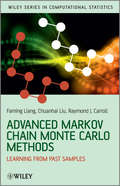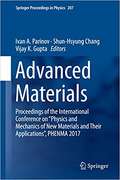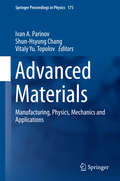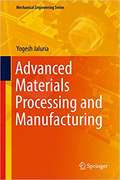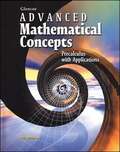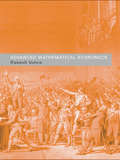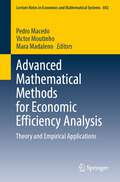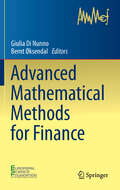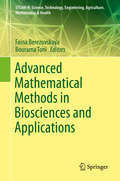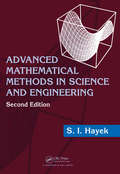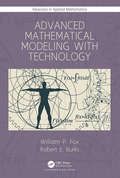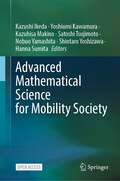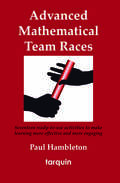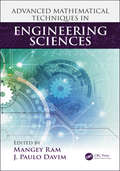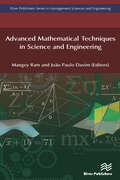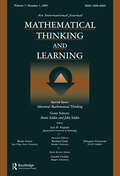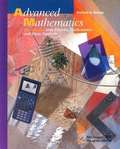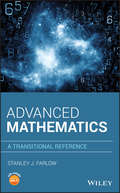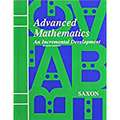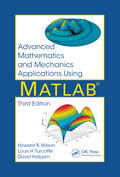- Table View
- List View
Advanced Markov Chain Monte Carlo Methods
by Faming Liang Raymond Carroll Chuanhai LiuMarkov Chain Monte Carlo (MCMC) methods are now an indispensable tool in scientific computing. This book discusses recent developments of MCMC methods with an emphasis on those making use of past sample information during simulations. The application examples are drawn from diverse fields such as bioinformatics, machine learning, social science, combinatorial optimization, and computational physics.Key Features:Expanded coverage of the stochastic approximation Monte Carlo and dynamic weighting algorithms that are essentially immune to local trap problems.A detailed discussion of the Monte Carlo Metropolis-Hastings algorithm that can be used for sampling from distributions with intractable normalizing constants.Up-to-date accounts of recent developments of the Gibbs sampler.Comprehensive overviews of the population-based MCMC algorithms and the MCMC algorithms with adaptive proposals.This book can be used as a textbook or a reference book for a one-semester graduate course in statistics, computational biology, engineering, and computer sciences. Applied or theoretical researchers will also find this book beneficial.
Advanced Materials: Proceedings Of The International Conference On Physics And Mechanics Of New Materials And Their Applications , PHENMA 2017 (Springer Proceedings In Physics #207)
by Shun-Hsyung Chang Ivan A. Parinov Vijay K. GuptaProvides a consistent and original presentation of fabrication techniques, physics, mechanics, and applications of advanced materials and composites.<p><p> Helps readers to better understand modern R&D requirements for prospective materials and composites.<p> Features original theoretical, experimental and modeling results on novel materials and devices.<p> This book presents selected peer-reviewed contributions from the 2017 International Conference on “Physics and Mechanics of New Materials and Their Applications”, PHENMA 2017 (Jabalpur, India, 14–16 October, 2017), which is devoted to processing techniques, physics, mechanics, and applications of advanced materials. The book focuses on a wide spectrum of nanostructures, ferroelectric crystals, materials and composites as well as promising materials with special properties. It presents nanotechnology approaches, modern environmentally friendly piezoelectric and ferromagnetic techniques and physical and mechanical studies of the structural and physical–mechanical properties of materials. Various original mathematical and numerical methods are applied to the solution of different technological, mechanical and physical problems that are interesting from theoretical, modeling and experimental points of view. Further, the book highlights novel devices with high accuracy, longevity and extended capabilities to operate under wide temperature and pressure ranges and aggressive media, which show improved characteristics, thanks to the developed materials and composites, opening new possibilities for different physico-mechanical processes and phenomena
Advanced Materials: Manufacturing, Physics, Mechanics and Applications (Springer Proceedings in Physics #175)
by Vitaly Yu. Topolov Shun-Hsyung Chang Ivan A. ParinovAdvanced materials are the basis of modern science and technology. This proceedings volume presents a broad spectrum of studies of novel materials covering their processing techniques, physics, mechanics, and applications. The book is concentrated on nanostructures, ferroelectric crystals, materials and composites, materials for solar cells and also polymeric composites. Nanotechnology approaches, modern piezoelectric techniques and also latest achievements in materials science, condensed matter physics, mechanics of deformable solids and numerical methods are presented. Great attention is devoted to novel devices with high accuracy, longevity and extended possibilities to work in wide temperature and pressure ranges, aggressive media etc. The characteristics of materials and composites with improved properties opening new possibilities of various physical processes, in particular transmission and receipt of signals under water, are described.
Advanced Materials Processing and Manufacturing (Mechanical Engineering)
by Yogesh JaluriaFocuses on new and advanced methods of manufacturing and materials processing with traditional methods described in light of the new approaches.<P><P> Maximizes reader understanding of the fundamentals of how materials change, what transport processes are involved, and how these can be simulated and optimized - concepts not covered elsewhere.<P> Introduces new materials and applications in manufacturing and summarizes traditional processing methods, such as heat treatment, extrusion, casting, injection molding, and bonding, to show how they have evolved and how they could be used for meeting the challenges that we face today<P>This book focuses on advanced processing of new and emerging materials, and advanced manufacturing systems based on thermal transport and fluid flow. It examines recent areas of considerable growth in new and emerging manufacturing techniques and materials, such as fiber optics, manufacture of electronic components, polymeric and composite materials, alloys, microscale components, and new devices and applications. The book includes analysis, mathematical modeling, numerical simulation and experimental study of processes for prediction, design and optimization. It discusses the link between the characteristics of the final product and the basic transport mechanisms and provides a foundation for the study of a wide range of manufacturing processes.
Advanced Mathematical Analysis and its Applications
by Pradip Debnath Delfim F. M. Torres Yeol Je ChoAdvanced Mathematical Analysis and its Applications presents state-of-the-art developments in mathematical analysis through new and original contributions and surveys, with a particular emphasis on applications in engineering and mathematical sciences. New research directions are indicated in each of the chapters, and while this book is meant primarily for graduate students, there is content that will be equally useful and stimulating for faculty and researchers. The readers of this book will require minimum knowledge of real, complex, and functional analysis, and topology. Features Suitable as a reference for graduate students, researchers, and faculty Contains the most up-to-date developments at the time of writing.
Advanced Mathematical Concepts: Precalculus with Applications
by Berchie Holliday Gilbert J. Cuevas Melissa S. Mcclure John A. Carter Daniel MarksLearn about relations, functions, graphs, trigonometry, discrete mathematics and calculus in this book.
Advanced Mathematical Concepts: Precalculus with Applications
by Glencoe StaffPrecalculus textbook, covering topics from graphing, to trigonometry, to conic sections, to the surface of calculus
Advanced Mathematical Economics (Routledge Advanced Texts in Economics and Finance)
by Rakesh V. VohraThis concise textbook presents students with all they need for advancing in mathematical economics. Detailed yet student-friendly, Vohra's book contains chapters in, amongst others: * Feasibility * Convex Sets * Linear and Non-linear Programming* Lattices and Supermodularity. Higher level undergraduates as well as postgraduate students in mathematical economics will find this book extremely useful in their development as economists.
Advanced Mathematical Methods for Economic Efficiency Analysis: Theory and Empirical Applications (Lecture Notes in Economics and Mathematical Systems #692)
by Pedro Macedo Victor Moutinho Mara MadalenoEconomic efficiency analysis has received considerable worldwide attention in the last few decades, with Stochastic Frontier Analysis (SFA) and Data Envelopment Analysis (DEA) establishing themselves as the two dominant approaches in the literature. This book, by combining cutting-edge theoretical research on DEA and SFA with attractive real-world applications, offers a valuable asset for professors, students, researchers, and professionals working in all branches of economic efficiency analysis, as well as those concerned with the corresponding economic policies. The book is divided into three parts, the first of which is devoted to basic concepts, making the content self-contained. The second is devoted to DEA, and the third to SFA. The topics covered in Part 2 range from stochastic DEA to multidirectional dynamic inefficiency analysis, including directional distance functions, the elimination and choice translating algorithm, benefit-of-the-doubt composite indicators, and internal benchmarking for efficiency evaluations. Part 3 also includes exciting and cutting-edge theoretical research on e.g. robustness, nonparametric stochastic frontier models, hierarchical panel data models, and estimation methods like corrected ordinary least squares and maximum entropy.
Advanced Mathematical Methods for Finance
by Giulia Di Nunno Bernt ØksendalThis book presents innovations in the mathematical foundations of financial analysis and numerical methods for finance and applications to the modeling of risk. The topics selected include measures of risk, credit contagion, insider trading, information in finance, stochastic control and its applications to portfolio choices and liquidation, models of liquidity, pricing, and hedging. The models presented are based on the use of Brownian motion, Lévy processes and jump diffusions. Moreover, fractional Brownian motion and ambit processes are also introduced at various levels. The chosen blend of topics gives an overview of the frontiers of mathematics for finance. New results, new methods and new models are all introduced in different forms according to the subject. Additionally, the existing literature on the topic is reviewed. The diversity of the topics makes the book suitable for graduate students, researchers and practitioners in the areas of financial modeling and quantitative finance. The chapters will also be of interest to experts in the financial market interested in new methods and products. This volume presents the results of the European ESF research networking program Advanced Mathematical Methods for Finance.
Advanced Mathematical Methods in Biosciences and Applications (STEAM-H: Science, Technology, Engineering, Agriculture, Mathematics & Health)
by Bourama Toni Faina BerezovskayaFeaturing contributions from experts in mathematical biology and biomedical research, this edited volume covers a diverse set of topics on mathematical methods and applications in the biosciences. Topics focus on advanced mathematical methods, with chapters on the mathematical analysis of the quasispecies model, Arnold’s weak resonance equation, bifurcation analysis, and the Tonnelier-Gerstner model. Special emphasis is placed on applications such as natural selection, population heterogeneity, polyvariant ontogeny in plants, cancer dynamics, and analytical solutions for traveling pulses and wave trains in neural models. A survey on quasiperiodic topology is also presented in this book. Carefully peer-reviewed, this volume is suitable for students interested in interdisciplinary research. Researchers in applied mathematics and the biosciences will find this book an important resource on the latest developments in the field. In keeping with the STEAM-H series, the editors hope to inspire interdisciplinary understanding and collaboration.
Advanced Mathematical Methods in Science and Engineering
by S.I. HayekClassroom-tested, Advanced Mathematical Methods in Science and Engineering, Second Edition presents methods of applied mathematics that are particularly suited to address physical problems in science and engineering. Numerous examples illustrate the various methods of solution and answers to the end-of-chapter problems are included at the back of t
Advanced Mathematical Modeling with Technology (Advances in Applied Mathematics)
by William P. Fox Robert E. BurksMathematical modeling is both a skill and an art and must be practiced in order to maintain and enhance the ability to use those skills. Though the topics covered in this book are the typical topics of most mathematical modeling courses, this book is best used for individuals or groups who have already taken an introductory mathematical modeling course. Advanced Mathematical Modeling with Technology will be of interest to instructors and students offering courses focused on discrete modeling or modeling for decision making. Each chapter begins with a problem to motivate the reader. The problem tells "what" the issue is or problem that needs to be solved. In each chapter, the authors apply the principles of mathematical modeling to that problem and present the steps in obtaining a model. The key focus is the mathematical model and the technology is presented as a method to solve that model or perform sensitivity analysis. We have selected , where applicable to the content because of their wide accessibility. The authors utilize technology to build, compute, or implement the model and then analyze the it. Features: MAPLE©, Excel©, and R© to support the mathematical modeling process. Excel templates, macros, and programs are available upon request from authors. Maple templates and example solution are also available. Includes coverage of mathematical programming. The power and limitations of simulations is covered. Introduces multi-attribute decision making (MADM) and game theory for solving problems. The book provides an overview to the decision maker of the wide range of applications of quantitative approaches to aid in the decision making process, and present a framework for decision making. Table of Contents 1. Perfect Partners: Mathematical Modeling and Technology 2. Review of Modeling with Discrete Dynamical Systems and Modeling Systems of DDS 3. Modeling with Differential Equations 4. Modeling System of Ordinary Differential Equation 5. Regression and Advanced Regression Methods and Models 6. Linear, Integer and Mixed Integer Programming 7. Nonlinear Optimization Methods 8. Multivariable Optimization 9. Simulation Models 10. Modeling Decision Making with Multi-Attribute Decision Modeling with Technology 11. Modeling with Game Theory 12. Appendix Using R Index Biographies Dr. William P. Fox is currently a visiting professor of Computational Operations Research at the College of William and Mary. He is an emeritus professor in the Department of Defense Analysis at the Naval Postgraduate School and teaches a three-course sequence in mathematical modeling for decision making. He received his Ph.D. in Industrial Engineering from Clemson University. He has taught at the United States Military Academy for twelve years until retiring and at Francis Marion University where he was the chair of mathematics for eight years. He has many publications and scholarly activities including twenty plus books and one hundred and fifty journal articles. Colonel (R) Robert E. Burks, Jr., Ph.D. is an Associate Professor in the Defense Analysis Department of the Naval Postgraduate School (NPS) and the Director of the NPS’ Wargaming Center. He holds a Ph.D. in Operations Research form the Air Force Institute of Technology. He is a retired logistics Army Colonel with more than thirty years of military experience in leadership, advanced analytics, decision modeling, and logistics operations who served as an Army Operations Research analyst at the Naval Postgraduate School, TRADOC Analysis
Advanced Mathematical Science for Mobility Society
by Kazushi Ikeda Yoshiumi Kawamura Kazuhisa Makino Satoshi Tsujimoto Nobuo Yamashita Shintaro Yoshizawa Hanna SumitaThis open access book presents the mathematical methods for huge data and network analysis.The automotive industry has made steady progress in technological innovations under the names of Connected Autonomous-Shared-Electric (CASE) and Mobility as a Service (MaaS). Needless to say, mathematics and informatics are important to support such innovations. As the concept of cars and movement itself is diversifying, they are indispensable for grasping the essence of the future mobility society and building the foundation for the next generation. Based on this idea, Research unit named "Advanced Mathematical Science for Mobility Society" was established at Kyoto University as a base for envisioning a future mobility society in collaboration with researchers led by Toyota Motor Corporation and Kyoto University.This book contains three main contents.1. Mathematical models of flow2. Mathematical methodsfor huge data and network analysis3. Algorithm for mobility societyThe first one discusses mathematical models of pedestrian and traffic flow, as they are important for preventing accidents and achieving efficient transportation. The authors mainly focus on global dynamics caused by the interaction of particles. The authors discuss many-body particle systems in terms of geometry and box-ball systems. The second one consists of four chapters and deals with mathematical technologies for handling huge data related to mobility from the viewpoints of machine learning, numerical analysis, and statistical physics, which also includes blockchain techniques. Finally, the authors discuss algorithmic issues on mobility society. By making use of car-sharing service as an example of mobility systems, the authors consider how to construct and analyze algorithms for mobility system from viewpoints of control, optimization, and AI.
Advanced Mathematical Team Races: Seventeen Ready-to-Use Activities to Make Learning More Effective and More Engaging
by Paul Hambleton17 ready-to-use photocopiable activities to use with students over 16 years. A team race is a classic idea - your team wins by answering all the questions correctly in the fastest time! Students enjoy the activity immensely and the quality of learning and discussion taking place is very high.
Advanced Mathematical Techniques in Engineering Sciences (Science, Technology, and Management)
by J. Davim Mangey RamThe goal of this book is to publish the latest mathematical techniques, research, and developments in engineering. This book includes a comprehensive range of mathematics applied in engineering areas for different tasks. Various mathematical tools, techniques, strategies, and methods in engineering applications are covered in each chapter. Mathematical techniques are the strength of engineering sciences and form the common foundation of all novel disciplines within the field. Advanced Mathematical Techniques in Engineering Sciences provides an ample range of mathematical tools and techniques applied across various fields of engineering sciences. Using this book, engineers will gain a greater understanding of the practical applications of mathematics in engineering sciences. Features Covers the mathematical techniques applied in engineering sciences Focuses on the latest research in the field of engineering applications Provides insights on an international and transnational scale Offers new studies and research in modeling and simulation
Advanced Mathematical Techniques in Science and Engineering
by Mangey Ram; Joãao Paulo DavimIn recent years, mathematical techniques applied to novel disciplines within the science and engineering have experienced extraordinary growth. Advanced Mathematical Techniques in Science and Engineering focusses on a detailed range of mathematics applied within various fields of science and engineering for different tasks. Topics of focus include:- Analysis of Consensus-Building Time in Social Groups- Modeling of intersystem accidents in critical infrastructure systems- Stochastic approaches to analysis and modeling of multi-sources and big data- Performance evaluation of computational DoS attack on access point in Wireless LANs- Ranking methods for decision-making under uncertainty- Understanding time delay based Modeling & Diffusion of technological products- Role of soft computing in science and engineering- Complex system reliability analysis and optimization- Tree growth models in forest ecosystems modellingThis research book can be used as a reference for students in a final year undergraduate engineering course, such as mechanical, mechatronics, industrial, computer science, information technology, etc. Furthermore, the book can serve as a valuable reference for academics, engineers and researchers in these and related subject areas.
Advanced Mathematical Thinking: A Special Issue of Mathematical Thinking and Learning
by Annie Selden John SeldenFirst Published in 2005. Routledge is an imprint of Taylor & Francis, an informa company.
Advanced Mathematics: Precalculus with Discrete Mathematics and Data Analysis
by Richard G. BrownMath textbook for high school students
Advanced Mathematics: Precalculus with Discrete Mathematics and Data Analysis
by Richard G. BrownNIMAC-sourced textbook
Advanced Mathematics: A Transitional Reference (Dover Books On Advanced Mathematics)
by Stanley J. FarlowProvides a smooth and pleasant transition from first-year calculus to upper-level mathematics courses in real analysis, abstract algebra and number theory Most universities require students majoring in mathematics to take a “transition to higher math” course that introduces mathematical proofs and more rigorous thinking. Such courses help students be prepared for higher-level mathematics course from their onset. Advanced Mathematics: A Transitional Reference provides a “crash course” in beginning pure mathematics, offering instruction on a blendof inductive and deductive reasoning. By avoiding outdated methods and countless pages of theorems and proofs, this innovative textbook prompts students to think about the ideas presented in an enjoyable, constructive setting. Clear and concise chapters cover all the essential topics students need to transition from the "rote-orientated" courses of calculus to the more rigorous "proof-orientated” advanced mathematics courses. Topics include sentential and predicate calculus, mathematical induction, sets and counting, complex numbers, point-set topology, and symmetries, abstract groups, rings, and fields. Each section contains numerous problems for students of various interests and abilities. Ideally suited for a one-semester course, this book: Introduces students to mathematical proofs and rigorous thinking Provides thoroughly class-tested material from the authors own course in transitioning to higher math Strengthens the mathematical thought process of the reader Includes informative sidebars, historical notes, and plentiful graphics Offers a companion website to access a supplemental solutions manual for instructors Advanced Mathematics: A Transitional Reference is a valuable guide for undergraduate students who have taken courses in calculus, differential equations, or linear algebra, but may not be prepared for the more advanced courses of real analysis, abstract algebra, and number theory that await them. This text is also useful for scientists, engineers, and others seeking to refresh their skills in advanced math.
Advanced Mathematics and Mechanics Applications Using MATLAB
by David Halpern Howard B. Wilson Louis H. TurcotteAdvanced Mathematics and Mechanics Applications Using MATLAB, Third Edition features extensive revisions that bring this best-selling text in line with MATLAB 6.x, especially its graphics and animation capabilities. It incorporates material on time dependent solutions of linear partial differential equations, a chapter on eigenvalue problems, and more than 300 pages of MATLAB solutions to important applications. The authors provide an abundance of additional physical examples related to heat conduction, inviscid fluid flow, geometrical properties, stress analysis, and multi-dimensional optimizations. The source code for all of the programs presented is freely available for download from the CRC website.
Advanced Mathematics for Applications
by Andrea ProsperettiThe partial differential equations that govern scalar and vector fields are the very language used to model a variety of phenomena in solid mechanics, fluid flow, acoustics, heat transfer, electromagnetism and many others. A knowledge of the main equations and of the methods for analyzing them is therefore essential to every working physical scientist and engineer. Andrea Prosperetti draws on many years' research experience to produce a guide to a wide variety of methods, ranging from classical Fourier-type series through to the theory of distributions and basic functional analysis. Theorems are stated precisely and their meaning explained, though proofs are mostly only sketched, with comments and examples being given more rominence. The book structure does not require sequential reading: each chapter is elf-contained and users can fashion their own path through the material. Topics are first introduced in the context of applications, and later complemented by a more thorough presentation.
